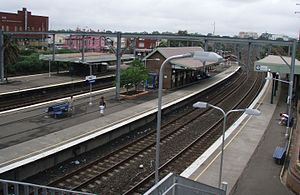Main Suburban railway line
| Main Suburban railway | |||||||||||||
|---|---|---|---|---|---|---|---|---|---|---|---|---|---|

New South Wales Metropolitan Rail Area with Main Suburban railway highlighted in black
|
|||||||||||||
| Overview | |||||||||||||
| Termini |
Redfern Granville |
||||||||||||
| Stations | 17 | ||||||||||||
| Services | |||||||||||||
| Operation | |||||||||||||
| Opened | 1855 | ||||||||||||
| Owner | RailCorp | ||||||||||||
| Operator(s) | Sydney Trains | ||||||||||||
| Technical | |||||||||||||
| Track length | 10 km (6.2 mi) | ||||||||||||
| Track gauge | Standard gauge | ||||||||||||
| Electrification | Overhead 1500V DC | ||||||||||||
| Operating speed |
|
||||||||||||
|
|||||||||||||

Main Suburban line through Croydon
|
|
| Line length | 21.2 km (13.2 mi) |
|---|---|
| Track gauge | 4 ft 8 1⁄2 in (1,435 mm) |
The Main Suburban railway line is the technical name for the trunk railway line between Redfern railway station and Parramatta railway station in Sydney, Australia, but now generally refers to the section between Redfern and where the Old Main South Line branches off at Granville Junction. This term distinguished this trunk line from the Illawarra Line which branched south from the Illawarra Junction to Wollongong, and later the North Shore tracks which carried trains north over the Harbour Bridge.
The Main Suburban line between Redfern and Granville is the first railway line to be constructed in New South Wales. The first company to start rail transport in New South Wales was the Sydney Railway Company which was incorporated on 10 October 1849 with the aim of building a railway from Sydney to Parramatta. Capital was raised, shares were sold, and a route was surveyed. The first sod was turned by Mrs Keith Stewart (daughter of the Governor) at Cleveland Paddocks (an area between the southern end of the current Sydney station and Cleveland Street) on 20 May 1850.
The original engineer appointed was Francis Webb Sheilds, an Irishman. He persuaded the New South Wales legislature to pass an Act on 27 July 1852 requiring all railways in the colony to be of 5 ft 3 in (1,600 mm) gauge. This was the gauge in use in Ireland and is now referred to as 1,600 mm gauge. After Sheilds resigned due to difficulties, a Scot named James Wallace was appointed. Wallace persuaded the legislature to repeal the previous act and replace it, on 4 August 1853, with one requiring a gauge of 4 ft 8 1⁄2 in (1,435 mm) - the current standard gauge. (Unfortunately for Australia, the legislation requiring the broad gauge had been noted in the colonies of Victoria and South Australia and some rolling stock ordered.)
...
Wikipedia
